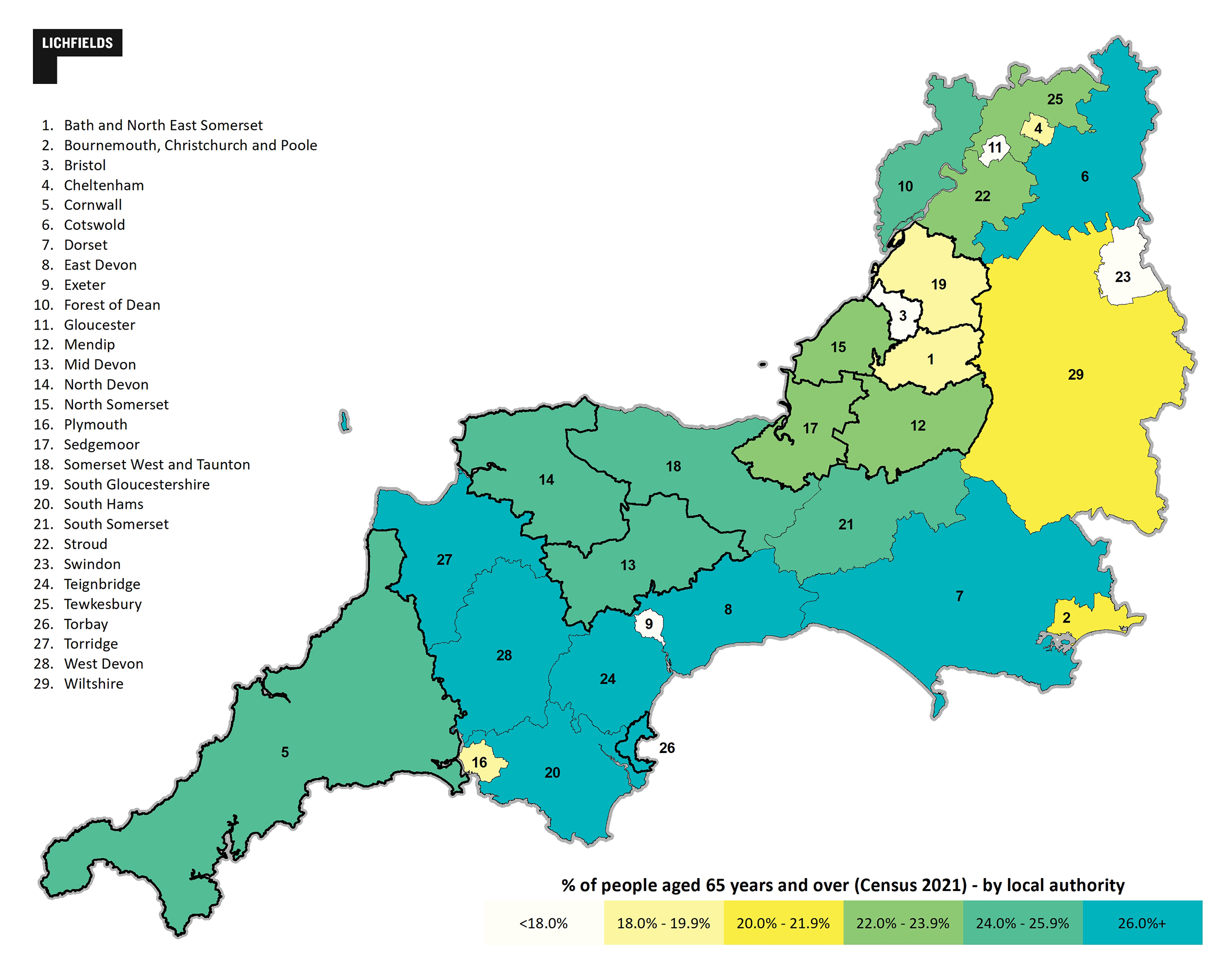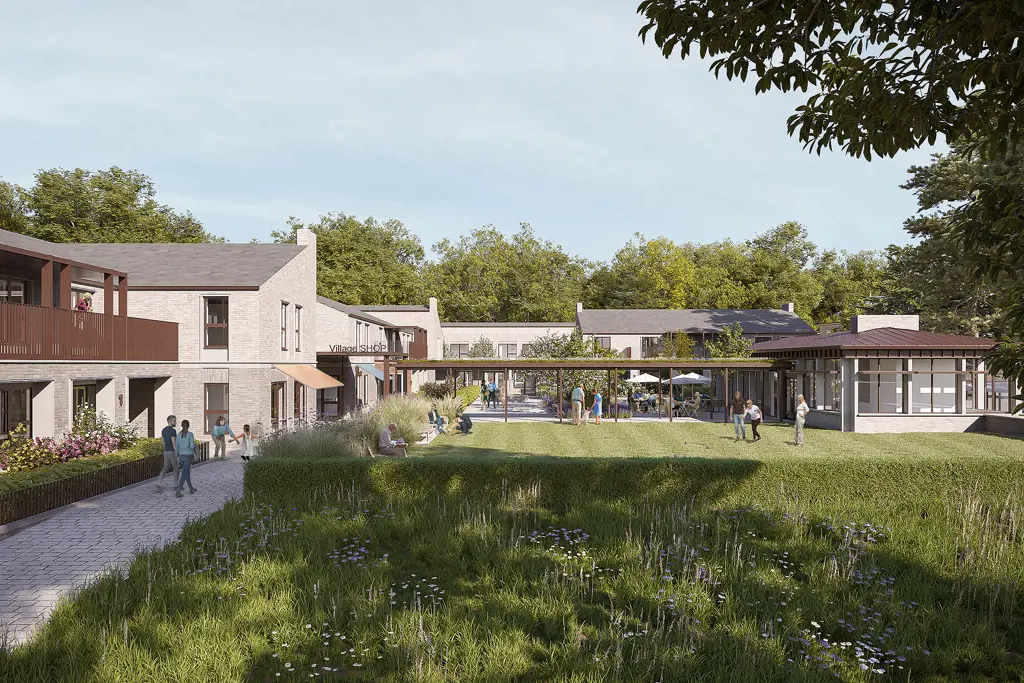South West Localised Delivery
To analyse delivery in the South West, Lichfields has reviewed a sample of ten local planning authorities (LPAs). These were selected to include a range of urban, rural and coastal authorities in the region, and avoid a bias of areas with typically older populations (e.g. the coastal regions). Of the LPAs studied, Table 1 shows the population % in each aged 65 and over, and how this has grown in the 10 years to 2021.
Table 1: % of total population aged 65 and over
| |
LPA
|
2011 +65
POPULATION %
|
2021 +65
POPULATION %
|
% CHANGE – PERCENTAGE POINTS (POPULATION INCREASE/DECREASE)
|
|
| |
Cornwall
|
21.7
|
25.3
|
+3.6 (28,959)
|
|
| |
Torbay
|
23.6
|
27.5
|
+3.9 (6,346)
|
|
| |
Mid Devon
|
20.4
|
24
|
+3.6 (4,035)
|
|
| |
BANES
|
18.1
|
19.3
|
+1.2 (5,583)
|
|
| |
South Gloucestershire
|
16.9
|
18.7
|
+1.8 (9,691)
|
|
| |
Bristol
|
13
|
12.9
|
-0.1 (4,928)
|
|
| |
N Somerset
|
21
|
24
|
+3 (9,367)
|
|
| |
N Devon & Torridge
|
26.2
|
26.9
|
+0.7 (9,114)
|
|
| |
Sedgemoor
|
20.6
|
23.8
|
+3.2 (6,335)
|
|
| |
Mendip
|
19.5
|
23.8
|
+4.3 (6,322)
|
|
Source: ONS Census data, 2021 and 2011.
Planning permissions
Having carried out a search of online planning history records, Lichfields has undertaken an initial review of planning permissions granted for elderly housing in each of the sample LPAs in the period from Local Plan adoption to April 2023. These are shown in Table 2. This is then compared to projected need calculated by Lichfields for the period 2021-2033, to understand how projected delivery (subject to these permissions being built-out, which is by no means certain, and a continued trend) compares to need, and giving an initial indication of how an LPA might perform in meeting its need.
Table 2: Annual permitted older people’s dwellings by LPA and Lichfields’ projected need in each LPA to 2033.
| |
LPA
|
Total older people’s dwellings permitted since LP adoption
|
Local Plan age (years to 2023)
|
Mean annual older people’s dwellings permitted
|
Projected annual need until 2033 (from 2021)*
|
Shortfall against average annual permissions to date
|
|
| |
Cornwall
|
677
|
7
|
96.71
|
391
|
2,064
|
|
| |
Torbay
|
230
|
8
|
28.75
|
88
|
474
|
|
| |
Mid Devon
|
10
|
3
|
3.33
|
41
|
113
|
|
| |
BANES
|
571
|
9 (since original, partial update in 2023)
|
63.44
|
75
|
104
|
|
| |
South Gloucestershire
|
1503
|
10
|
150.3
|
103
|
-473
|
|
| |
Bristol
|
298
|
12
|
24.83
|
90
|
782
|
|
| |
N Somerset
|
246
|
5
|
49.2
|
111
|
309
|
|
| |
N Devon & Torridge
|
98
|
5
|
19.6
|
111
|
457
|
|
| |
Sedgemoor
|
11
|
4
|
2.75
|
88
|
341
|
|
| |
Mendip
|
174
|
9
|
19.33
|
86
|
600
|
|
*Data provided by Housing LIN identifies a national average of 170 units of specialist accommodation for every 1,000 people over the age of 75. This comprises 145 units of sheltered accommodation and 25 extra care bedspaces. These figures have been applied to the projected increase in the number of people over the age of 75 in each local authority area between 2021 and 2033 (based on the 2021 census and the 2018-based Sub National Population Projections). The figures presented represent the annualised assessment of future need. In considering these figures, it is important to note that the demand for such facilities is not necessarily limited to people over the age of 75. Many sheltered housing schemes are available for people over the age of 55 or 60 and to the evidence of need based on the increase in the number of people over the age of 75 may serve to under-estimate the true level of need that exists.
Based on the average of annual dwellings permitted, of the ten sample LPAs, only South Gloucestershire Council could meet its projected need for older people’s dwellings over the next ten years, should current permission rates continue/permitted schemes be built-out; the shortfalls are very significant.
With the exception of South Gloucestershire and BANES, permissions to date show a trend of meeting less than half of the projected annual need to 2033.
This initial research evidences substantial under-delivery across the South West and an ongoing and worsening position whereby current need is unmet each year; this gap is only set to widen looking at Lichfields projected need to 2043 (see graph below). Cumulatively, and in the context of an increasing ageing population, this will inevitably lead to a growing crisis in older people’s housing. This must be urgently addressed by both national and local government through proactive planning policy, decision making and monitoring, as the implications of under-supply are significant and include: a failure to adequately cater for elderly needs; people living in unsuitable and unsustainable accommodation; substantial costs to the NHS and an inability to free-up much needed housing for other population age cohorts, with knock-on impacts on the wider housing crisis.
*Data provided by Housing LIN identifies a national average of 170 units of specialist accommodation for every 1,000 people over the age of 75. This comprises 145 units of sheltered accommodation and 25 extra care bedspaces. These figures have been applied to the projected increase in the number of people over the age of 75 in each local authority area between 2021 and 2033, and 2021 and 2043 (based on the 2021 census and the 2018-based Sub National Population Projections).
Monitoring
Lichfields has reviewed the Annual Monitoring Reports (AMRs) for the sample LPAs. Only three of the ten include permissions granted for C2 units for older people: Sedgemoor, Mid-Devon and South Gloucestershire. These report permissions granted, not delivery. Our projections estimate that, from 2021 to 2033, 1,050 older people’s C2 and sheltered C3 units will be needed in Sedgemoor. However, Sedgemoor’s AMR shows no older people’s C2 units were permitted in 2020/21 – clearly more needs to be done to address need and secure delivery.
Cornwall monitors care home bed figures independently of its AMR, although only states the total loss/gain of beds. However, the authority does not monitor sheltered care accommodation. Despite delivering an additional 35 care home beds between 2021 and 2022, the net loss in beds for the period is -314, starkly juxtaposing trends in population data. Their need for care home beds increases by 23 beds per annum.
The other LPAs in the sample do not monitor housing for older people within their AMRs.
To ensure the needs of the growing population aged 65 and over are met, a consistent approach is needed. This should support a Plan-led approach to planning for and delivering for this important cohort of the population, and in turn freeing up the standard housing stock for the younger demographic. If under-delivery continues and the population continues to age (which it will) then the issue will clearly worsen, and it is necessary that this is given policy attention on a national basis; it has implications across the board.
In the absence of supportive policy and proactive allocation, it continues to fall to promoters/developers/providers to demonstrate need and how this differs from standard market housing. This was the approach taken by Lichfields for a recent scheme in Torbay.






